
1. Things to do before concrete placement:
♦ The method of placing the concrete and the pouring duration should be determined in advance.
♦ The molds should be durable, clean and lubricated (Figures 1-2).
♦ If the concrete will be poured on a ground, the ground should be compressed and dampened to render it ready for the casting.
♦ When the concrete is being received, the properties of the product ordered should be controlled stating from the dispatch note.

2. Things to do during concrete placement:
♦ Concrete should be poured into the mold at a height not greater than 1.5 meters. Otherwise, the concrete will segregate and the mold might break (Figure 3).
♦ Concrete should be poured as horizontal layers.
♦ Vertical members such as columns and partitions should be filled in minimum three times (Figure 4).
♦ The concrete should be poured at the area that is closest to where it will be placed.
♦ A vibrator should be used to compress the concrete except for special types of concrete like self-compacting concrete.

♦ It is necessary to dip the tip of the vibrator quickly and remove it from the concrete slowly.
♦ The tip of the vibrator should never touch the molds.
♦ The vibrator should be immersed vertically into the concrete and the immersion interval should not be greater than 45-50 cm depending on the impact radius of the vibrators.
♦ The areas compressed should be vibrated in an overlapping manner (Figure 5). During vibration, plunging the vibrator into the previous layer down to 10 cm every time will allow the layers to blend (Figure 6).

♦ The tip of the vibrator should not be kept for too short or too long within the fresh concrete, and a suitable vibrator tip should be selected depending on the thickness of layer (Figure 8).
♦ As a result of too little, extreme or improper vibration, the fine and coarse contents of the concrete disintegrate. Resulting in breaking the homogeneity of the concrete, this disintegration is called segregation. Segregation should be avoided.
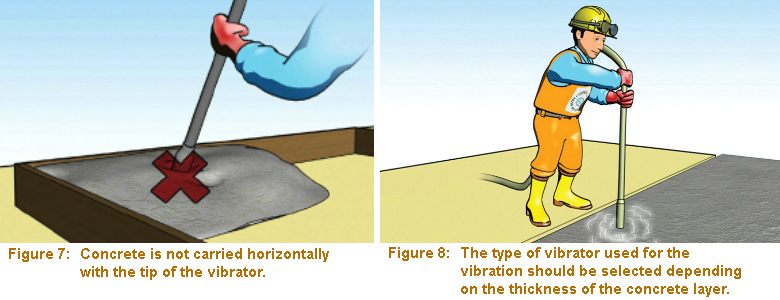
4. Concrete Surface Finishing:
Since vertical surfaces are generally in touch with the molds, molds in different quality and type are used depending on the desired surface quality. After removal of the mold, the surface is sometimes further finished manually or using a machine. Mostly, horizontal surfaces and certain inclined surfaces are finished without molds. In such type of finishing process, machine methods may also be used.
In concrete paving, the surface finishing is generally performed with steel or timber floats and trowels. Where it is necessary to finish edges, bevels and joints, first the edges should be finished and then the bevels and joints.
B) MAINTENANCE OF CONCRETE
Concrete maintenance, i.e. concrete curing, prevents potential water loss after concrete placement or production of concrete products and ensure proper and timely hydration reactions. Cement hydration takes days, weeks and even months. Continued hydration reaction required adequate water and temperature. Unless the necessary conditions are met, the concrete cannot provide the expected resistance and durability (Figure 9-10).
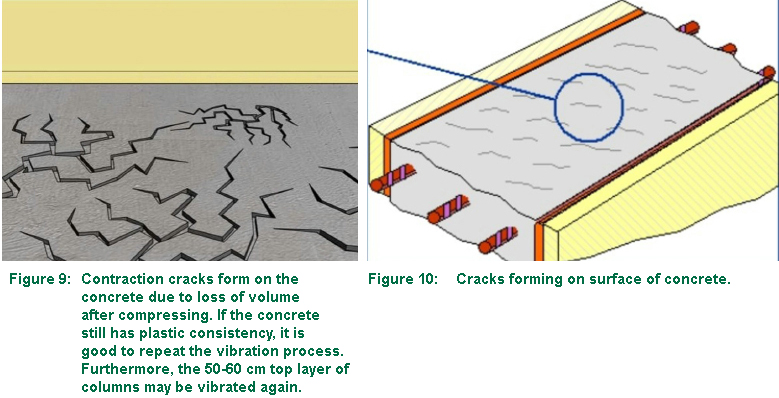
There are three steps to follow to prevent drying of the concrete due to water loss and ensure continuation of cement hydration:
♦ The surface of the concrete is covered with a waterproof (nylon-polyethylene) cover.
♦ The surface of the concrete is always kept damp. In general, it is hosed or sprayed with a mechanical system or a water pond is created.
♦ The loss of water on the surface of the concrete is reduced using chemical curing admixtures.
In particular, when working on concretes that have large surface, the amount of water lost due to evaporation will result in slowdown of hydration reactions.
1. Water Curing:
The surface of the concrete should be kept wet at all times (Figure 11). The ideal curing duration is approximately 7 days. This duration should be extended during winter months. Dampening the concrete surface by spraying water is a very good curing method (Figure 12). If this process is performed at intervals, it should be made sure that the surface of the concrete is not left dry. The single disadvantage of this system is its cost. The system requires sufficient amount of water and experienced operators for it to work properly. The concrete surface may also be kept damp and the evaporation may be minimized by using curing blanket or similar water retaining covers (Figure 13). In order to prevent deformations on the surface, water retaining covers should be laid as soon as the concrete is hardened. Attention should be paid to the edges of the paving. The covers should always be kept wet.
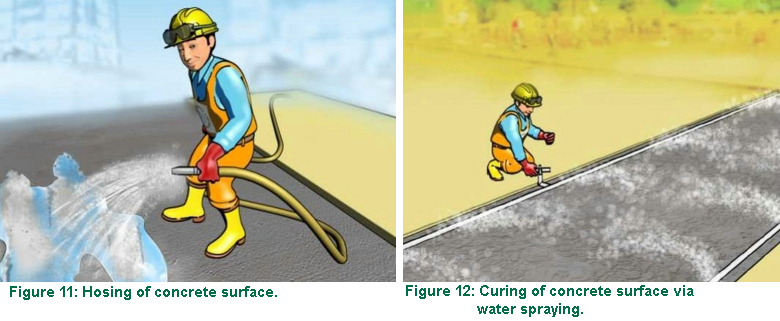
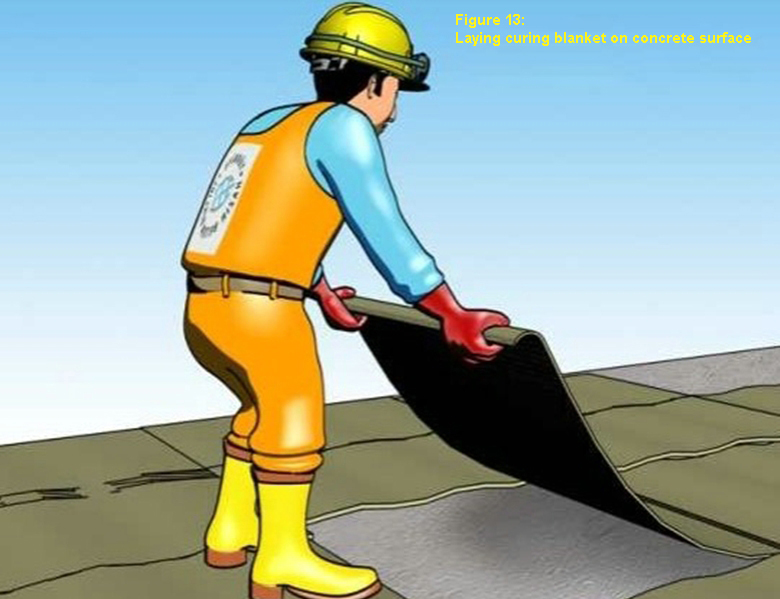
As seen in Figure 14, the chemical curing materials applied vary by the type of the work performed. White or aluminum-colored chemicals create a fine polymer film on the surface of concrete. The water content of the liquid material evaporates in time and the chemical content of the compound create a membranous layer on the concrete surface. This layer not only minimizes evaporation but also ensures refraction and reflection of sunrays on the concrete surface.

Polyethylene covers should be applied within half an hour after the molds are removed from the vertical members and as soon as the concrete is hard enough (Figure 15). The application should be started before the concrete surface dries. In case of print concrete or patterned road concrete, the covers should be placed on a light frame. This way, the surface of the concrete shall not be deformed.
For this type of curing, it is not necessary to wait for the water content of the concrete to bleed and evaporate before placing polyethylene covers. The curing can be started when the concrete is placed.

C) CASTING CONCRETE IN COLD AND HOT WEATHER
1. Casting Concrete in Cold Weather:
In case the average temperature of three consecutive days is less than +5°C, it is necessary to take precautions against cold weather. When ordering concrete, the effects of weather conditions on the concrete should be taken into consideration. The temperature of the concrete received should be controlled. In case of rainy weather conditions, especially field and slab concrete pouring should be postponed if it is not possible to take precautions; or the works may be continued if proper precautions can be taken in advance (such as heating the concrete casting area or isolating it from the external environment) (Figure 16). It may also be necessary to isolate or heat the contact surfaces of the ground or the mold in advance.
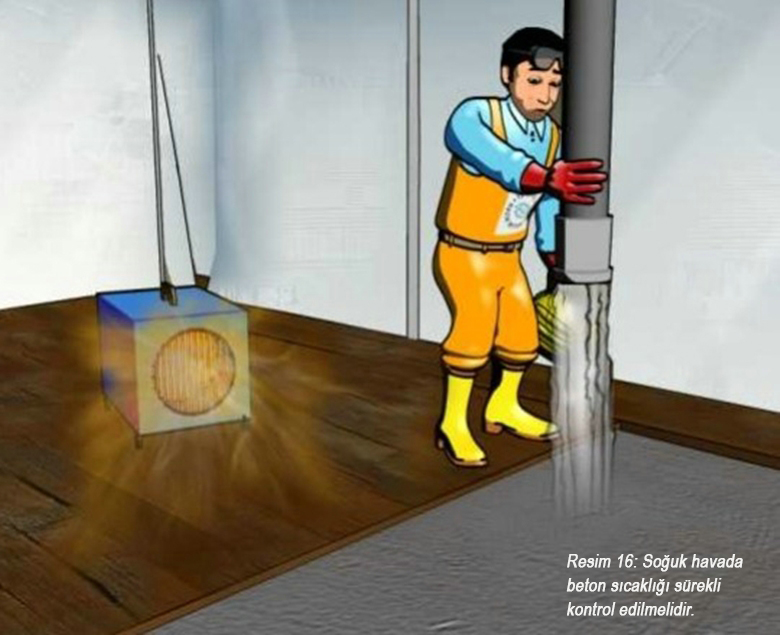
The materials and equipment required to protect the concrete from early freezing during and after placing the concrete should be kept available at the worksite. In general, insulating blankets and plastic covers are used. The corners and edges are most sensitive to loss of heat and require greater precautions. When removing the protective heat insulating materials, it should be paid attention that there are no sudden temperature changes.
Köşe ve uç noktalar ısı kaybına en hassas yerlerdir ve daha fazla önlem gerektirirler.
Koruyucu ısı yalıtım malze-meleri kaldırılırken ani sıcaklık değişimi olmamasına dikkat edilmelidir.
2. Casting Concrete in Hot Weather:
In case the average temperature of three consecutive days is greater than +30°C, it is necessary to take precautions against hot weather. The most important thing to pay attention when casting concrete in hot weather is to prevent the concrete from losing water. The precautions to be taken are as follows:
The ground where the concrete will be poured is dampened and saturated with water. This way, the ground is prevented from absorbing the water content of the fresh concrete.
♦ Molds and fittings are dampened.
♦ If it is extremely windy, the windbreaker may be placed around the area of casting.
♦ The concrete may be protected from sunlight using shades.
♦ All workers and the necessary equipment should be ready for pouring the concrete.
♦ The concrete should be poured during the hours when the temperature decreases during the day.
♦ The temperature of the concrete should be checked continuously.
♦ The concrete should not be vibrated extremely.
♦ The pouring process should take place within the shortest time.
♦ The surface finishing should be performed as soon as there is no bleeding water left on the surface.
♦ Precautions should be taken immediately to prevent the surface of the concrete from drying.
Kaynak: Türkiye Hazır Beton Birliği www.thbb.org
